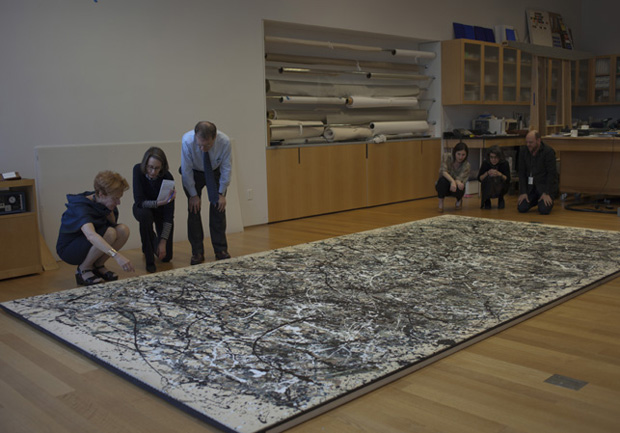
MoMA's Jackson Pollock mystery
Museum restoration team uncovers later brushstrokes and gains a greater understanding of the modern master
Few artists are as famous for their painting technique as Jackson Pollock. In Hans Namuth's 1950s photographs, the late abstract expressionist is seen dancing around his floor canvasses as he flecked them with industrial paints, while in the Hollywood biopic, Pollock, Ed Harris re-enacts the great mid-century action painter. Yet a recent restoration project at the Museum of Modern Art in New York calls into question this seemingly random paint flinging, to reveal a new whole new picture entirely.
MoMA considered its work, One: Number 31, 1950, a good candidate for restoration, following the museum's 1998 Pollock retrospective, as portions of this canvas looked quite different from other works by the artist from that time. Upon further inspection MoMA's restoration professionals, James Coddington and Jennifer Hickey, came across a series of more careful, feathered, brushstrokes on the work, which did not seem to match other pieces made by Pollock around the same time.
Photographs of One: Number 31, 1950 taken in 1962 do not show these brush strokes, suggesting they were perhaps later editions, made some time after Pollock's own death in 1956, but before MoMA acquired the canvas in 1968.
{media1}
Using combined methods of X-ray and ultraviolet examinations, as well as chemical tests, the conservators found that these later strokes were made with a wholly different paint, formulated from a resin unseen elsewhere in Pollock's paintings.
The later additions appear to cover up cracks which MoMA's team has since chosen to leave exposed, in order to remain faithful to the artist's original intentions. What's more, Coddington and Hickey also worked out that some of the paint drips on One: Number 31, 1950 could not have been formed if the painting had been laid to dry on Pollack's studio floor and, with the help of further supporting photographs, have ascertained that these later drips must have been added towards the end of Pollock's process, when the painting was lent upright, in order for him to finish it off.
{media2}
These finer points aside, the MoMA team says its restoration work has renewed its respect for the artist's work, and that the paintings were far more carefully created than casual gallery goers might imagine. The newly restored work, now on view on MoMA's fourth floor, reveals a weft of silk-light paint lines, giving the work a marbled look. What's more, the gallery has now chosen to display the work on the gallery floor, as Pollock would have viewed it throughout most (though not all) of its creation. The conservators say that this huge canvas, which is almost three meters wide, and over five meters long, a more direct, human quality, perhaps closer to Pollock's own vision.
To read more about their work, see the MoMA blog, or this New York Times article. For a greater understanding of Pollock and his contemporaries, please consider our Abstract Expressionism book, which offers a comprehensive survey of the epic and influential movement centred in New York in the decades following the Second World War.